One of Tom King’s most beloved arcs on Batman was the War of Jokes and Riddles. What happens when they go to war? The Dark Knight has done a good job of keeping armies of bad guys at bay, but what happens when they go to war? That same question is addressed in The War of Jokes and Riddles, as terrible as it may be.
The Joker and the Riddler resolve to battle, thereby separating the Batman villains into two groups. As a result, Batman finds himself in the middle of their fight, entrusted with damage control and defending the city from these villains who have no regard for human life and only care about themselves. This story is recounted in flashbacks and occurs during Batman’s formative days as the Dark Knight of Gotham.
In 2017, “The War of Jokes and Riddles” was published. The eight-issue story saw the Joker and Riddler go to battle with each other, with the entirety of Gotham caught in the middle. It was drawn by Mikel Janin, Colored by June Chung, and lettered by Clayton Cowles. The story largely took place during Bruce Wayne’s second year as the Dark Knight, when he teamed up with Jim Gordon and his occasional opponent Kite-Man to save more innocent lives.
This is essentially a story-within-a-story which Bruce tells Catwoman soon after proposing to Selina Kyle earlier in the run of King. Selina and Bruce maintained their romantic relationship whilst she considered the proposal, uncertain if she was ready to commit to her long-term companion and lover in marriage. Bruce chooses to tell Selina about the battle and a pivotal point in the war that will shock him to his core at the end of the conflict one night. Let us get started!
The War of Jokes and Riddles – The Beginning of the End
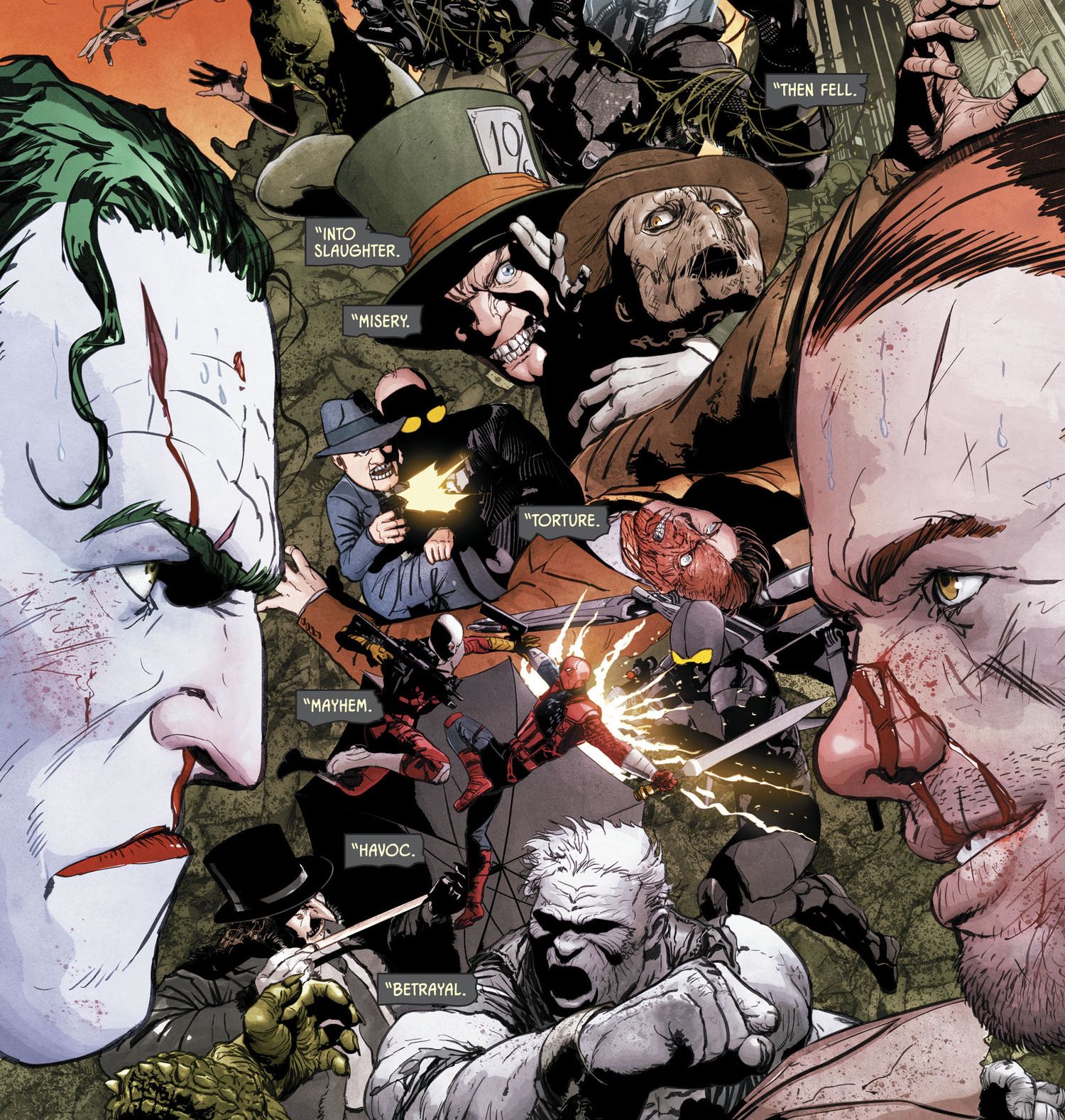
In Batman #25, the “War of Jokes and Riddles” begins, and it’s the perfect way to kick off the second year of DC Comics’ Rebirth era. The issue opens in the middle of one of the Joker’s murderous plots as he’s auditioning stand-up comedians and then killing them if they don’t make him laugh — with narration boxes in King’s trademark poetic style informing us that what we’re seeing is a flashback, a story being told in the past tense by an outside observer. The Joker makes his first appearance in Rebirth’s Batman book proper, and the introduction is appropriately unsettling.
The Riddler, on the other hand, does not have the same issues as Joker. We meet him, also in his Rebirth debut, staging a violent and clearly smarmy prison break, despite the blood on his hands, with a sneer pasted to his face. The contrast King is creating is immediately clear — Eddie Nigma standing next to a Joker in the midst of a nasty existential crisis — and Janin’s meticulously designed layouts sell it beautifully.
A back-to-back double-page, single-panel spread splits the issue, with the Riddler alone in the Joker’s office, requesting “Knock, knock.” The Joker, alone at his desk and followed by a fresh viewpoint on the same room, responds, “Who’s there?” Two sides of one lethal coin: a call and a reaction.
The issue then picks up speed. Commissioner Gordon has gathered several cops outside the Joke Factory in preparation for going inside when the building is engulfed in flames by a massive explosion. As the cops try to figure out what’s going on, the Joker emerges from the shadows and murders two cops in the ensuing commotion.
Guards corner Nigma at the prison and instruct him to stand down, but Nigma begins listing persons who are close to each of the guards in front of him. The guards get concerned for the safety of their loved ones and let Nigma leave the prison unhurt. In another part of Gotham City, the Joker says something that makes his driver laugh, so he shoots him, forcing the car to smash into a nearby fountain.
Joker emerges from the wreckage and begins strolling toward one of Gotham’s residential buildings. At the same moment, Nigma arrives at the crash site and enters the same tower as Joker. After that, Nigma recites a series of numbers that takes him to a luxury residence. “Knock, knock,” he says as he steps in. “Who’s there,” says Joker, who is seated at a desk. Nigma says “an answer,”.
The two villains meet and Nigma tries convincing Joker to take down Batman together, as a team but the Joker shoots him in the stomach and walks away. In the present, Bruce tells Selina that after the first meeting between the Joker and the Riddler, Gotham City was split for the next few months as the two villains went to battle.
The building suspense in Batman #25 serves to heighten the reader’s anticipation for what promises to be a great, epic arc that will touch practically every part of the Batman rogues gallery and the character himself.
Look to the Past, it’ll Explain the Future
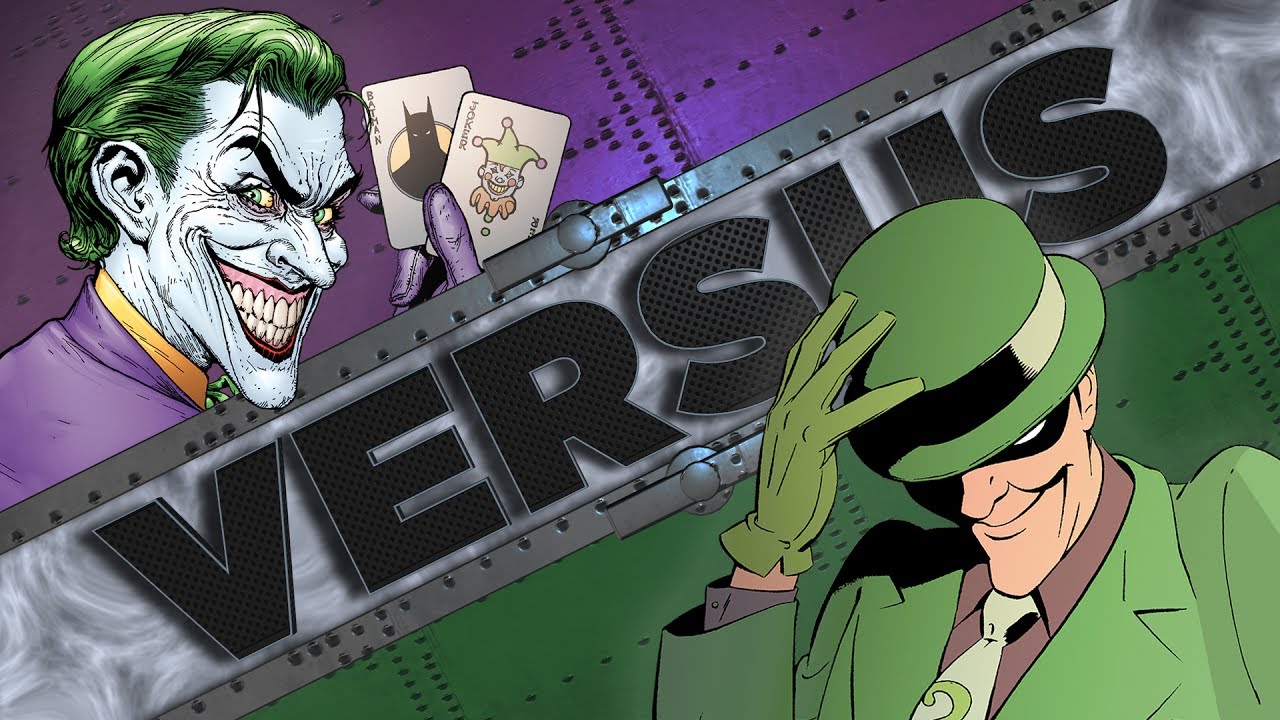
For the second part in a brilliantly written comic, Tom King pays homage to historical Batman aspects, while Mikel Jann beautifully executes them. In Batman #26, the second part of Tom King and Mikel Jann’s “The War of Jokes and Riddles” begins, as a new dynamic between two of Batman’s most legendary enemies emerges. Both darkly comical foes played major roles in Scott Snyder and Greg Capullo’s New 52 run on the comic, albeit in largely separate plots. Here, King uses the chance to provide a narrative for these two supervillains that extends beyond their shared hatred of the Dark Knight.
For the second part in a brilliantly written novel, Tom King pays homage to historical Batman aspects, while Mikel Jann beautifully executes them. In Batman #26, the second part of Tom King and Mikel Jann’s “The War of Jokes and Riddles” begins, as a new dynamic between two of Batman’s most legendary enemies emerges. Both darkly comical foes played major roles in Scott Snyder and Greg Capullo’s New 52 run on the comic, albeit in largely separate plots. Here, King uses the chance to provide a narrative for these two supervillains that extends beyond their shared hatred of the Dark Knight.
In “The War Of Jokes And Riddles,” Batman #26 continues to set the stage for what’s to come in “The War Of Jokes And Riddles.” After this issue, we have a better understanding of all of the important actors in the fight between the Joker and the Riddler. We get much more development of this version of both villains as we build up both sides of the fight.
The writing for both the Joker and the Riddler is the best part of Batman #26. Tom King knows just how to make both of his characters extremely dangerous. Despite the fact that their names make them appear cartoonish, neither character is amusing. The terror that both characters inspire in others in Gotham City demonstrates how terrible they are.
This issue thus largely follows the two villains as they go about recruiting other villains and outlaws to join their team in the upcoming epic battle. The strategy taken by Joker and Riddler in recruiting others to their side was the key difference. With the Joker, we see how he exploits his terrifying reputation to entice people to him. On the other hand, Riddler’s conversation with Poison Ivy revealed that he wants to form a more cooperative alliance with his villain recruits. It’s a significant distinction that builds on the initial encounter between the Joker and the Riddler in Batman #25.
Caught in the Middle
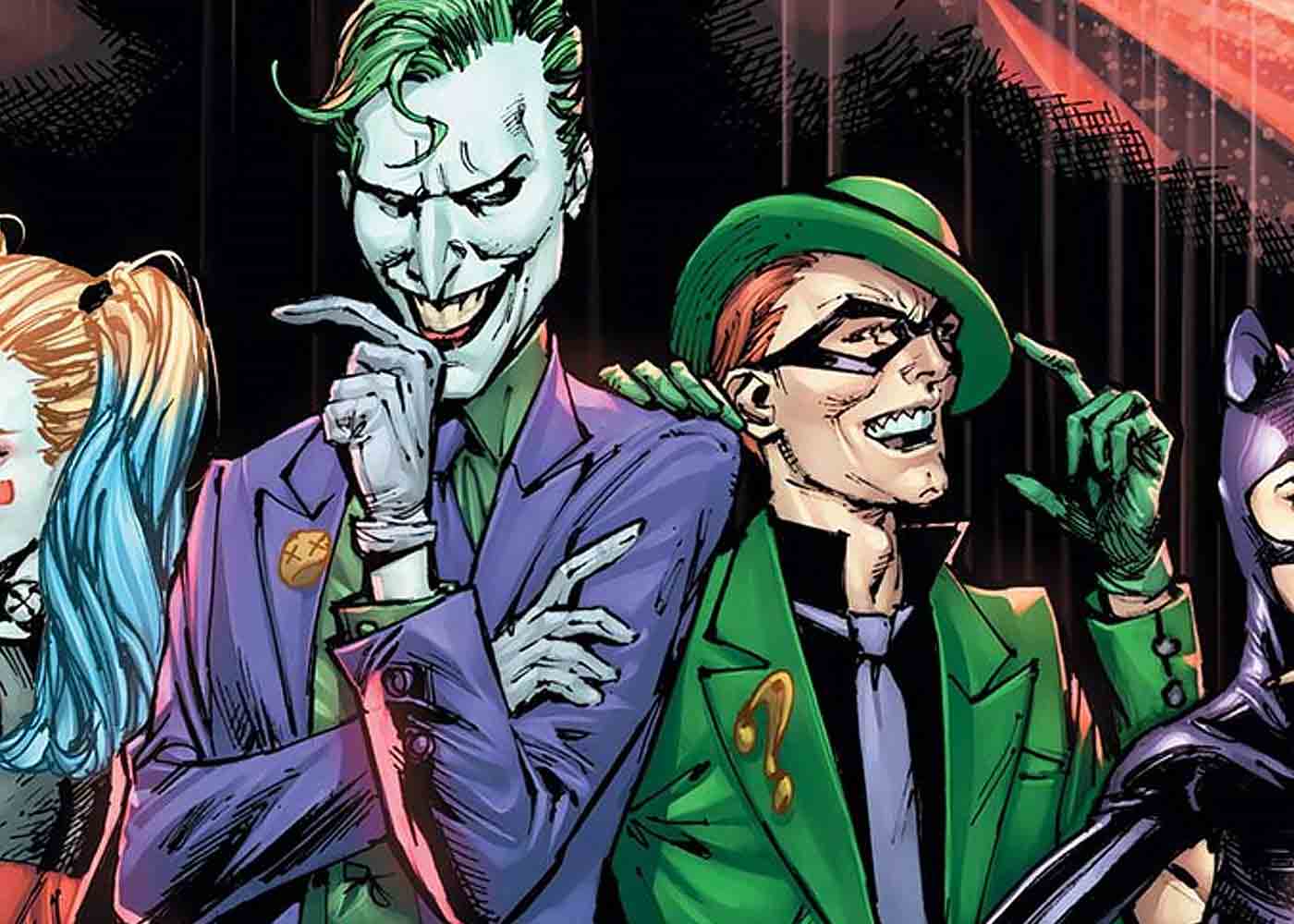
We follow a low-level criminal as he becomes entangled in the ongoing conflict between Batman, The Joker, and The Riddler in this issue. Tom King gives us a story that might stand alone but adds a layer of sadness to a supervillain who would otherwise be a Z-lister. We witness how unjust it can be when Batman comes knocking and demands information, as well as the collateral damage that can befall even those who are attempting to do the right thing.
This interlude serves as a brief and welcome change of pace for the arc. It humanizes Kite Man in a way that fits nicely with his objectives and the current plot. It also follows the general theme of this arc, with Batman blaming the war on his own existence. It tells a highly personal story about a Batman adversary in order to provide the reader with a different viewpoint on previous events.
The narrative of Charles Brown, the upcoming Kite Man, is told in this issue. He is dragged against his will into the “War of Jokes and Riddles,” where he ends up as a double, triple, and even quadruple agent. His shifting allegiances can be linked to the fact that he has no desire to be involved in the battle at all; he is merely reacting in whatever way will keep him and his family safe, almost like a kite in the wind. Nonetheless, the battle breaks him by the end of the issue. His son is gone, and he has lost trust in his beliefs, leading him to turn into a villain and enter the fight on his own terms.
An intriguing aspect of this story is that Batman, not the Joker or the Riddler, was the one who drew Kite Man into the conflict. Batman coerced him into gathering information on the Joker, nearly killing him in the process. He would not have gotten engaged if Batman hadn’t appeared, and his kid would still be alive today.
In fact, throughout this storyline, King has hinted that Batman holds himself responsible for each and every death caused by his foes. He’s probably thinking about the age-old Batman fan question, “Does Batman’s existence give rise to the very criminals he’s trying to stop?” This is a question that Batman fans debate all the time, so it’s nice to see the comics take on the topic.
The War is Afoot
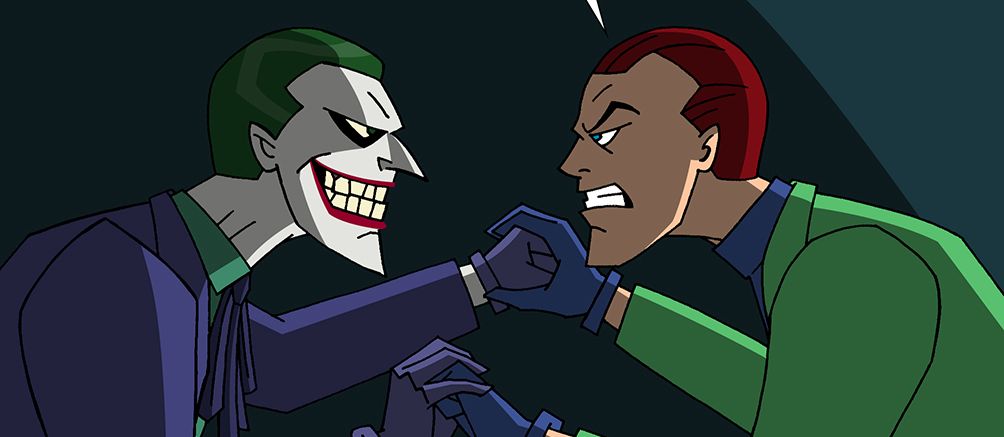
Commissioner Gordon sets up separate meetings with the Joker and the Riddler while the conflict between them wreaks devastation on Gotham City. Gordon is obligated to perform particular tasks at each meeting. He must meet with Riddler wearing only boxers. He is compelled to wear a prisoner uniform and a black bag over his head in order to meet with Joker. After completing both tasks, he is taken on a tour of Gotham City, where he meets with each villain at different times throughout the day.
Gordon then states that the Joker and the Riddler both want Batman delivered to them in order to put a stop to the battle. Batman, on the other hand, feels they should hit both sides. Gordon claims it won’t be simple because the Joker has planted wired bombs across Gotham City and the Riddler has citizens kidnapped all over the city. Gordon, on the other hand, is opposed to his scheme.
Batman #28 was at its best when it showed how the battle between the Joker and the Riddler had decimated Gotham City. The clearest example of this is the fight between Deadshot and Deathstroke. The commentary King provides Bruce to explain what is going on in these sequences adds to the idea that the conflict between the two best mercenaries in the DC Universe is a war. It appeared as if Deadshot and Deathstroke had begun their own personal fight in order to establish who was the best.
Batman was eventually able to corner Deathstroke and Deadshot after five days of gunshots and bombs. Batman takes advantage of the triple-threat conflict and manages to knock out both Deathstroke and Deadshot at the same moment. Later that night, Gordon tells Batman that while he was fighting Deathstroke and Deadshot, the Feds dispatched two special force units to try to neutralize both sides of the conflict. Joker’s forces eventually track them down and eliminate them all.
He then leaves a note for Gordon, stating that he was unable to locate any camouflage but did discover a large amount of blood. Meanwhile, the Riddler calls Gordon to say he’s prepared to clear up the “mess.” In the present, as Batman and Gordon debate what to do next, Bruce informs Selina that Deadshot was near death when Batman took him out but was miraculously recovered by the doctors.
All of this adds to the impression that the overarching War of Jokes and Riddles altered the course of Gotham City’s future.
A Dinner to Remember
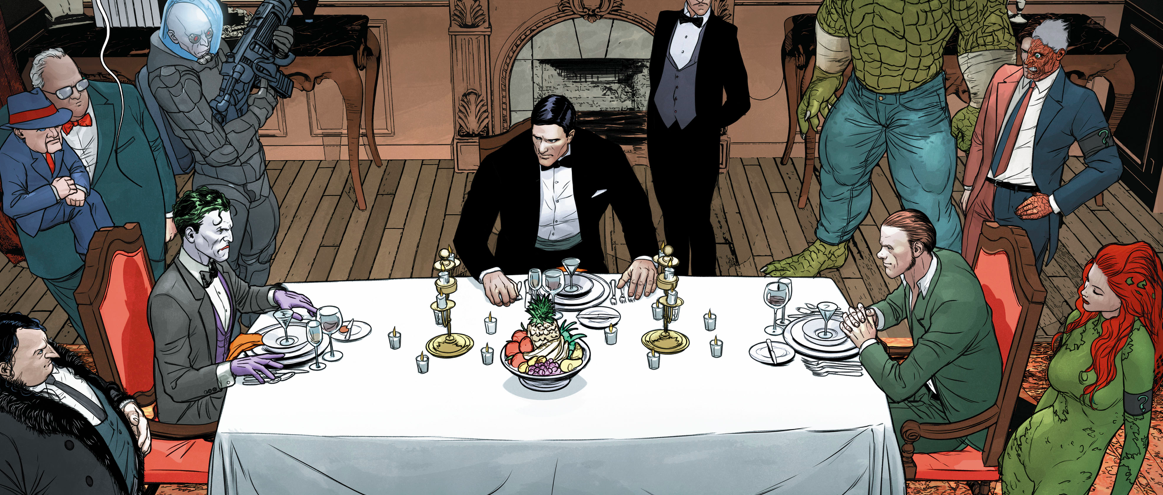
In Batman #29, Tom King assembles his chess pieces over the dinner table, beginning the fourth part of the “War of Jokes and Riddles.” The ruthlessness with which Joker and Riddler have fought each other has taken its toll. Gotham is in shambles, so Bruce Wayne decides to offer a million-dollar reward to the most likely Batman killer.
Batman appears to have finally set his trap, pitting the two wordsmiths against one another using both personalities. Batman #29 is Tom King’s most dialogue-heavy issue ever, with only a few panels of action. The conversation is worthy of any classic gangster film, and the imagery is simple yet vibrant.
It’s a peaceful night in Gotham, despite the recent atrocities and city-wide destruction. Gotham’s most unusual dinner party in years takes place at the mansion on the hill. Tom King invites his rival kings, the Joker and the Riddler, to share a meal with Bruce Wayne, the city’s prodigal son. This historical perspective is ideal.
This War is shown in such a way that it feels legendary as if history were happening in each issue. King’s Riddler is so fantastic that one hopes the writer will include him in Batman’s future as well.
A nine-course meal surrounded by all of your worst enemies? It may be counterintuitive, but Bruce Wayne will explain: “In my youth, my mother used to say, ‘When everything else fails, have supper,'” he recalls, still recounting the terrifying events of “The War of Jokes and Riddles” to Catwoman in retrospect.
Understanding, or attempting to comprehend, Batman’s company: the Joker and the Riddler, is the focus of Batman #29. It’s a character study as well as a deconstruction, and it’s a hilarious one at that. But, like with other dinner-centered stories — My Dinner with Andre comes to mind — you’ll get out of the meal what you put into it.
Here we get discussions of what it’s like to witness a guy die after his head is removed from his body; what each villain will do to Batman once they defeat him; and assessments of what each villain genuinely represents. With Batman #29, King and Janin arrive prepared and precise, delivering another solid installment in the “War of Jokes and Riddles,” despite the odd and sluggish pace that some might expect for a war.
In Batman #29, “The War of Jokes and Riddles” reached a breaking point, with the Dark Knight being forced to choose sides. Will he side with the erratic Joker? Or does he choose the side of the dubious Riddler? This issue demonstrated that there is no middle ground between the two, and Batman must choose between the two sides of his greatest adversaries.
Batman and Riddler – An Unlikely Alliance
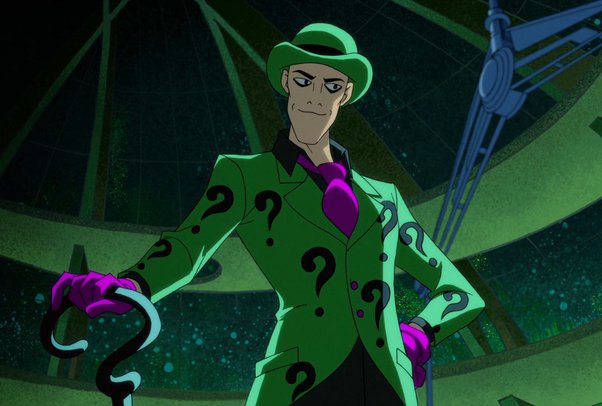
While Batman #30 is referred to as an interlude chapter in “The War of Jokes and Riddles,” it is arguably the best issue of the epic story arc. Writer Tom King is able to generate a strong sense that the scales are leaning to one side by returning the attention back to Kite Man.
As a result, King sets the scenario for things in Gotham City to become even more chaotic. Kite Man demonstrates how even a comedic villain may play a significant role in a story. King achieves this not by re-inventing Kite Man to make him more deadly, but by leveraging Kite Man’s status as a joke to advance the plot of “The War of Jokes and Riddles.”
The fact that Batman and Riddler purposefully left Kite Man behind to be the only “survivor” of Joker’s army gave the character a significant position on the chessboard, even if it wasn’t on his side. Kite Man, as was seen in the previous issue, has a lot of reasons to support Joker. And it was Kite Man’s own preoccupation with a vengeance that blinded him to his own frailty. Kite Man’s tragic character was rendered even more terrible by his inner monologue, which was revealed to be a former discussion with his son over whether he was a joke.
Kite Man’s appearance also served to emphasize Batman’s agreement with Riddler not to kill anyone. Despite confronting some of Gotham City’s most formidable villains, King was able to demonstrate Batman’s power over Riddler by siding with the enemy. The exchange between Two-Face and Riddler in particular demonstrated how critical it is for Riddler to have Batman by his side as the conflict with the Joker has progressed.
The fact that members of Joker’s own army view Batman and Riddler’s cooperation as a route out adds to the sense of escalation. The fact that Cluemaster is frank about it indicates that Joker’s power in the conflict has waned. And now that Batman and the Riddler have teamed together, it’s the ideal opportunity for these particular villains to exit the ongoing conflict.
This creates an even more fascinating dilemma, as Joker is cornered and has no one to help him. The Batman and Riddler alliance’s placement of Joker in this predicament has made him even more dangerous than when he had an army of villains on his side.
Because, as we know from the Joker, he is at his most deadly when he is alone and has no one to care about. The character now has no allegiance to anyone other than himself in order to win. That could end up being the worst conceivable situation for Batman and Riddler in this battle, and they’ll only have themselves to blame.
Now that the full narrative has been retold because Bruce wanted to confess to Selina the terrible decision that has plagued him for the most of his Batman career, King has added to the mystery of what that decision is with this issue. Bruce’s decision to go with the Riddler is already a difficult one to expose, but with a few issues left, it doesn’t appear that this is the objective of the plot. That makes you question whether the Joker would do something to drive Batman to make a more sinister decision that will alter how he is perceived in Gotham City.
The Joker’s Wild Card
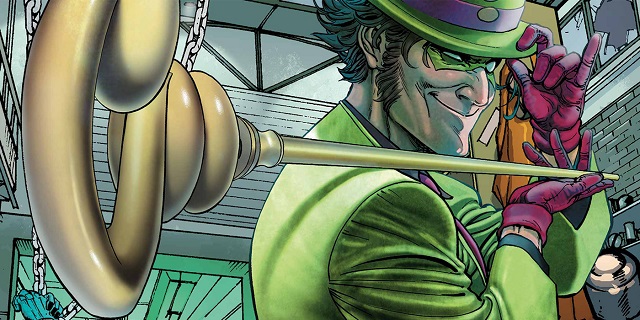
With his back against the wall, it appears that Joker will be forced to use the last wild card he claims that he has up his sleeve. Knowing the Joker, this may be the worst-case scenario for Batman, the Riddler, and the city of Gotham. Will the War of Jokes and Riddles come to a conclusion? This is precisely what we discover in Batman #31.
The most dangerous version of the Joker is one who is left to his own devices. That is demonstrated by Joker’s out-of-control behavior in Batman #31. That, combined with the way both Batman and the Riddler act, sets the setup for one of the most interesting Batman arcs in recent memory.
The issue begins with Joker going completely insane as he interrogates a nervous man about being remembered, setting the tone for the rest of the issue. It painted Joker as someone who has nothing left to lose and is succumbing to his own madness. With that mindset, Batman and Riddler’s cautious approach to the Joker’s lair made even more sense. At this moment, Joker will go all out, knowing that Batman and the Riddler are on their way to get him, and he is eager to take them out with him.
The issue also spends more time delving into Batman and Riddler’s relationship after they became partners in the previous issue. Tom King made it obvious that this is a shaky partnership, with Batman and Riddler still holding secrets from one other, demonstrating a significant lack of trust.
That factored into how Batman and the Riddler used Kite Man to carry out their own schemes. With so much time spent building Kite Man up to be more than a one-dimensional villain, King gave the character the fitting payoff in Batman #31. Kite Man’s ultimate vengeance against the Riddler felt well deserved. It was all part of Batman’s plan to stay one step ahead of Riddler, which made it even sweeter.
This all served to emphasize how the Riddler’s mental overconfidence is always his undoing. Riddler knew Joker wouldn’t be able to fight back at this time. Knowing this helped Batman devise a strategy that the Riddler would not anticipate. It also serves as an illustration of how someone as intelligent as Riddler will always fail because he lets his arrogance to overwhelm him as soon as he senses success.
Batman’s plan to create a scenario in which he, the Joker, and the Riddler are the last ones standing adds to the mystery behind his darkest decision. It’s still unclear what Batman will do to bring the War of Jokes and Riddles to a close. Given how Bruce speaks to Selina now, it appears that it was a major shift in the status quo. Tom King and Mikel Janin do a wonderful job of building the tone for the big finale, which sees Batman, the Joker, and the Riddler locked in a room together.
The Final Showdown
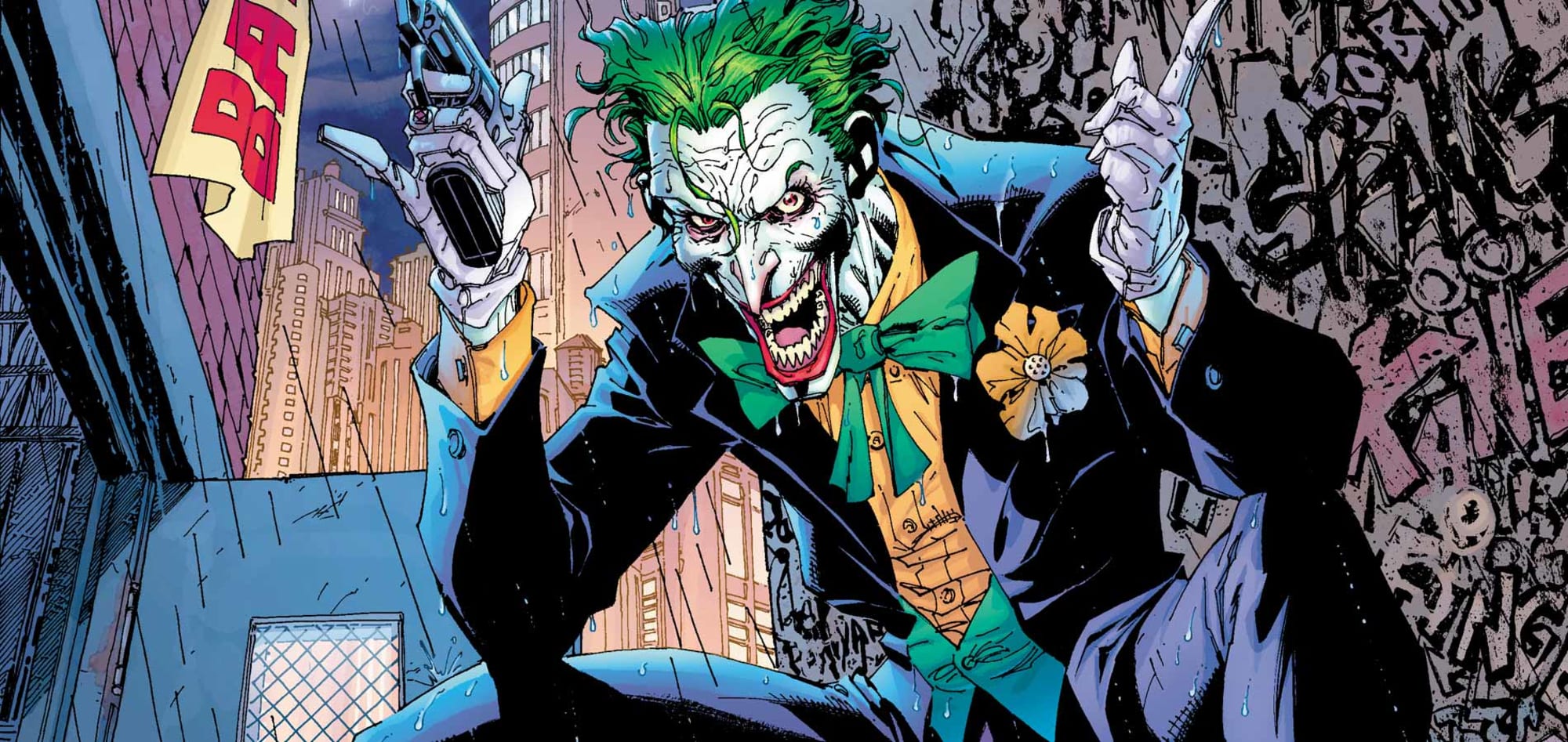
And finally, we come to the grand finale of this epic conflict that ravaged Gotham City. This series closes exactly where it began, with three men, including Kite Man, fighting for Gotham City in one final battle, and there’s a lot to unpack here. Cowles and Jann let loose as the letters POP off the pages, fists are thrown, and weapons are snatched in a three-way brawl that spans multiple panels. Jann makes it very clear to follow the action as it intensifies, with the typography of the blows changing colors and sounds, all before Riddler crashes the party with a summary of what the entire War was really about in the first place.
The implosion of The Riddler has gone into great detail about the entire War storyline, bringing King’s mainstays full circle with their “true” roles in the Joker’s and Riddler’s Games. It’s oddly depressing for The War Of Jokes And Riddles to come down to a conflict between a joke and a riddle in the larger scheme of things, but then again, that’s how it all started in the first place, right? He also looks into why the villains keep Batman around long enough to combat him.
The Kite-Man Interludes provide us with the moment that changed Batman and led to this story being told in the first place. The premonition of what’s to come begins slowly, almost ghostlike, with the majority of the color and motion focused on the clueless Riddler’s ranting. The impossible happens, and it’s startling if you think of Batman as he is, rather than as he was. A man pushed to the breaking point and beyond, who tries to put an end to it all, and the flashback that haunted Bruce Wayne for years has come to an end. Against the shouting Riddler and monotonous Joker, Batman remains silent and unflappable throughout.
Everything is irrevocably changed in the end. Batman now owes the Joker. Joker effectively saved the Dark Knight’s life by preventing him from killing Riddler. It’s the Clown Prince of Crime’s greatest joke, the one that finally makes him laugh, and potentially the one he’ll laugh at forever. Riddler has also been altered.
His entire motivation, to make Joker laugh, reveals him to be as unstable as any of Gotham’s Rogues. He’s just as much of a chaos agent as the Joker, and his craziness is palpable. Finally, Selina’s answer does not demonstrate her love for Bruce. It’s the reason she says yes. Her final monologue eloquently opens up her heart to the audience that has rooted for her and Batman forever.
When it’s all said and done, anyone Tom King’s runs is deserving of being considered a classic. ‘The War of Jokes and Riddles,’ however, will be remembered as something exceptional. It’s one of those arcs, and this is one of those issues, that will be acknowledged, written about, and discussed by comic book readers when they talk about pivotal events in their favorite characters’ lives. And with that, we come to the end of this video. Let us know your favorite part of this storyline in the comments below!
